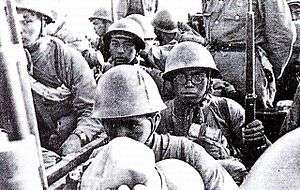Battle of Zaoyang–Yichang
The Battle of Zaoyang–Yichang, also known as the Battle of Zaoyi, was one of the 22 major engagements between the National Revolutionary Army and Imperial Japanese Army during the Second Sino-Japanese War.
Background
The Japanese were seeking a quicker solution to achieve a Chinese surrender. The Japanese contemplated moving directly down the Yangtze to the relocated Chinese capital, Chongqing. To do so, they would need to capture a critical town in western Hubei province, Yichang.
The Japanese attack did not commit many troops or material, which enabled the main Chinese commander, Li Zongren, who had frustrated the Japanese before, to repel the Japanese.
Battle
On 1 May, the Japanese forces began a drive towards Zaoyang. They pushed towards the 5th warzone's strongholds in the Tongbaishan and Dahongshan mountains, attempting to draw the Chinese forces into a battle and destroy them with a pincer movement. The Chinese strategy aimed to let the Japanese forces run low on supplies, and then destroy them.
Aftermath
The Japanese casualties were 2,700 troops killed and 7,800 wounded. The occupation of Yichang gave the Japanese an advantageous base for air attacks against Chongqing. Furthermore, it dealt a considerable blow to the morale and fighting capacity of the Chinese as no large-scale offensive was mounted after this operation.[6]
See also
References
- ↑ http://dl.ndl.go.jp/info:ndljp/pid/1041952/106
- ↑ China. Hsüan ch'uan pu (1943). China After Five Years of War. Gollancz. p. 62.
- ↑ Bulletin of International News. Association for International Understanding. 1941. p. 1770.
- ↑ Philippine Magazine. Philippine Education Company. 1940. p. 62.
- ↑ Felix Reburreccion Hidalgo; Charles E. Griffith, jr. (1928). Philippine Magazine. Philippine Education Company. p. 62.
- 1 2 3 4 5 Central China area operation record 1937-1945 (PDF) (Report). Japanese Monograph. 179. Tokyo, Japan: Headquarters, USAFFE and eighth U.S. Army, Office of the chief of military history department of the army. 21 December 1955. pp. 215–218. Retrieved 8 February 2018.
- ↑ JACAR(Japan Center for Asian Historical Records)Ref.C11110494300、China General Army statistics in January 1941 (containing seven attached charts) . From January 1941(National Institute for Defense Studies)
Sources
- Hsu Long-hsuen and Chang Ming-kai, History of The Sino-Japanese War (1937–1945) 2nd Ed., 1971. Translated by Wen Ha-hsiung, Chung Wu Publishing; 33, 140th Lane, Tung-hwa Street, Taipei, Taiwan Republic of China. Page 334-339, Map 20, 21
- van de Ven, Hans. War and Nationalism in China: 1925-1945,
External links
- "Occupation of Shashi", Nippon News, No. 3. in the official website of NHK.
- "Occupation of Yichang", Nippon News, No. 4. in the official website of NHK.
Coordinates: 32°07′31″N 112°45′04″E / 32.1252°N 112.7510°E
